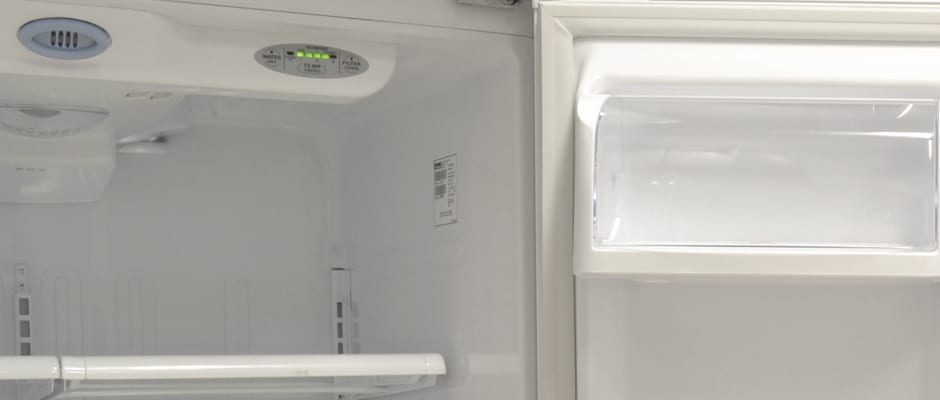Introduction
Front
{{section_header}}{{section.name}}{{/section_header}}
The front has a glossy, smooth finish white that looks and feels excellent. It's not quite as high-end as a stainless finish, but it certainly looks sharper than a more traditional matte finish found on mid-level fridges.
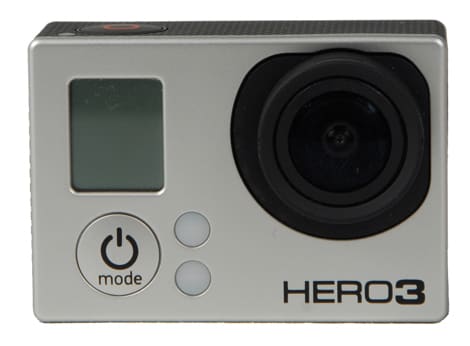
Even though it's white, this fridge is surprisingly stain resistant. Fingerprints and every-day smudges show up hardly at all given the white coloring, and the smooth texture makes wiping off any stains a breeze. Unlike matte finishes, there aren't any little cracks for spills to settle into, either.

There are two sets of controls on this fridge, but both are very low-tech and easy to learn. In the fridge, right in front at the top of the compartment, is a little scale from 1 to 5 that controls that fridge's temperature. There's a button to push in order to adjust it, as well as a button that locks the water dispenser shut and a warning light notifying you when the filter needs to be changed. In the freezer is a simple switch that can be pushed up or down to select a number from 1 to 5. Both of these have a clearly labeled manufacturer's recommended setting.

The handles on this appliance are recessed into the top and bottom of the freezer and fridge doors, respectively. This means you don't have to worry about anything sticking out into your kitchen, and the handles remain large enough to offer a solid grip. Also, for those with a different kitchen orientation, the doors appear to be reversible.

There is a small spout located to the left of the fridge's temperature controls. It's colored blue, distinguishing it from the rest of the panel, and just has to be pushed on to make it work. Since it's inside the fridge, there's no spot to rest your glass on, making it a two-hand device.

Interior
{{section_header}}{{section.name}}{{/section_header}}
The inside of the {{product.brand.name}} looks much like many of the other mid-level Kenmore fridges that we've tested. Both compartments, though, have a few little touches that make for some more varied and flexible storage options.
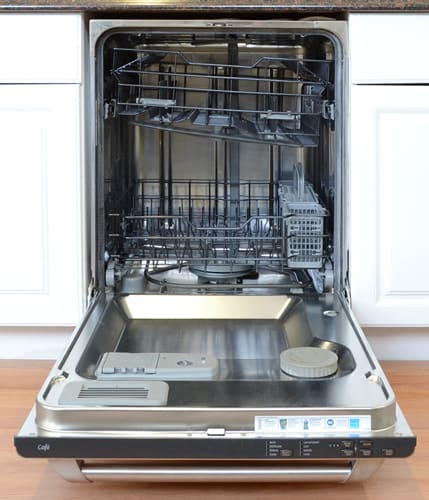
The interior of the CDWT980VSS.
The fridge interior is broken up using a fairly traditional layout. There are four half-width shelves that mount onto the rear of the fridge using hooks. Affixed to the bottom of one of these is a deli drawer. At the bottom is a full-width shelf, and all of these are set above to matching crisper drawers.
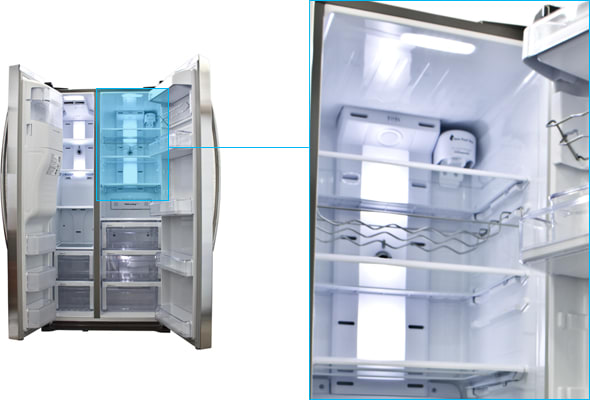
One of the half-width shelves, positioned on the top right here, has a retractable portion that allows you to shift the front half of it back. While this blocks up some storage space on the shelf below, it also allows you to refrigerate taller items if you should need the space and don't want to actually remove a shelf.
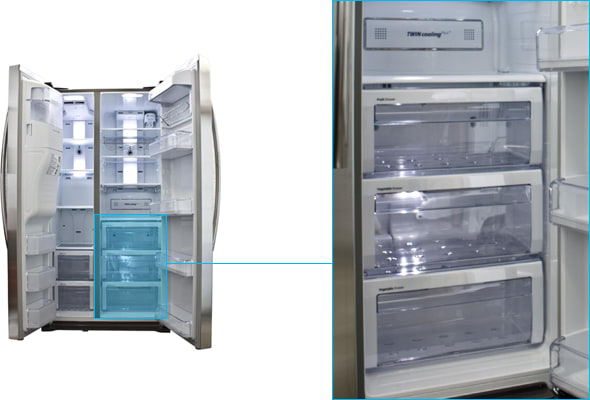
The filter is located directly to the left of the actual water dispenser, inside the fridge compartment. It slides in horizontally, locked into place with a twist. All the directions are clearly labeled.
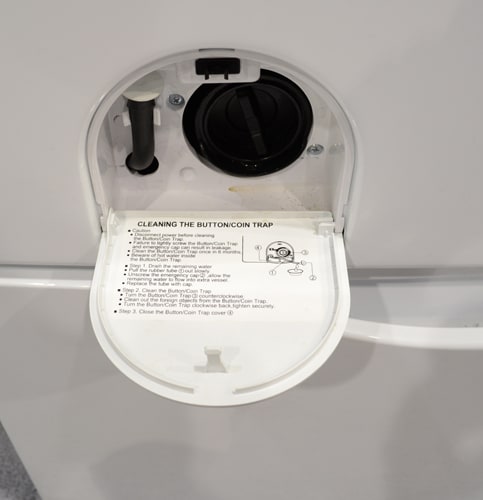
The {{product.brand.name}}'s fridge door is surprisingly flexible, and can be altered to suit almost any door storage need. At the top is a standard dairy bin, as well as an open, flat tray. It's an unusual addition, and it's declining angle and open lid makes it suitable for a plethora of options - you can stack light bagged foods without them taking up space that could be used for taller items on other shelves, or use it as a reminder spot and keep your lunch for the next day there without having to dig around for it in the morning. Under these are three identical bucket shelves than can be repositioned, and at the very bottom is a full-width fixed shelf.
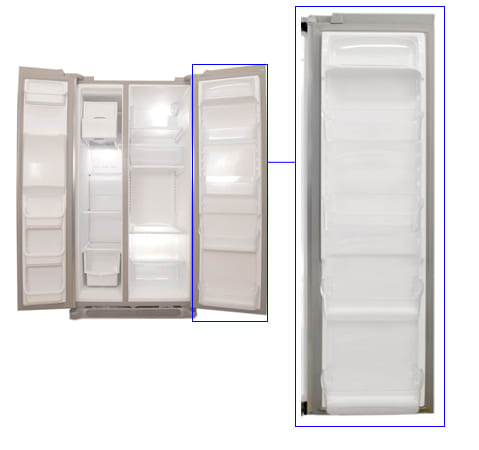
The main portion of the freezer is exactly what you'd expect. A single wire shelf separates it into two sections. A bulk ice maker is found in the top left corner, and the fridge comes with an optional ice tray. If you want to move the shelf up, though, keep in mind that the ice tray only fits when the shelf is on its lowest rung.
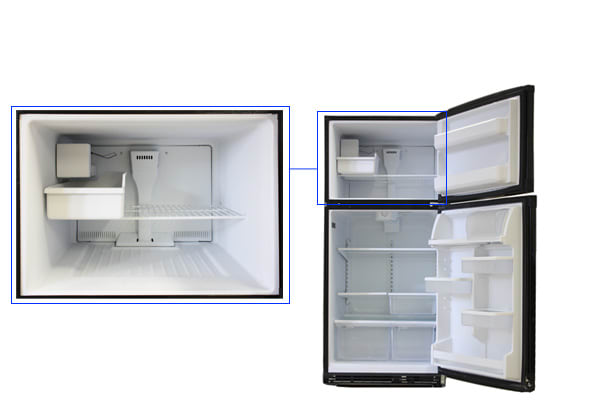
Like many freezer doors, the {{product.brand.name}} has two shelves for food storage. In a twist, though, the top shelf has a very eye-catching design. Instead of being a traditional shelf, it looks almost like a wire trap that can be tipped forward, and items are then placed down into it. This is great storage for loose frozen treats like popsicles or ice cream sandwiches, as you can stack them and take advantage of the vertical space without worrying about them rolling away.
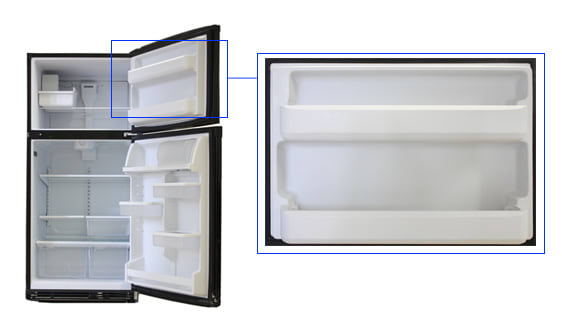
The ice maker is of a traditional kind, located in the top left corner of the freezer and operated using a single switch.
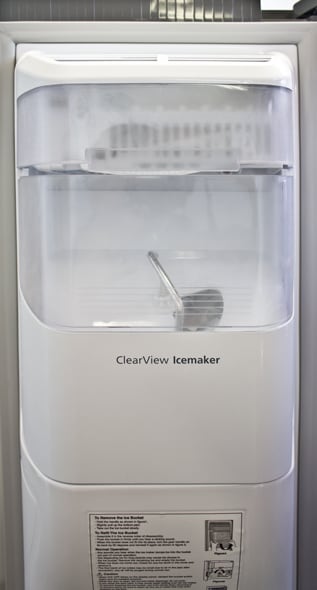
Back
{{section_header}}{{section.name}}{{/section_header}}
The {{product.brand.name}} has a full-backed metal covering. There's a removable port for any sort of repair access, as well as a panel near the bottom that covers the water port for the ice maker and water dispenser.
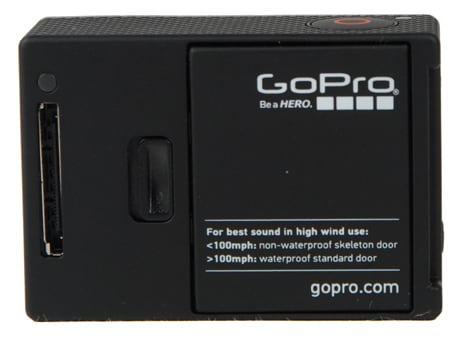
Sides
{{section_header}}{{section.name}}{{/section_header}}
Unlike the front, the sides have a white matte finish instead of a glossy one.
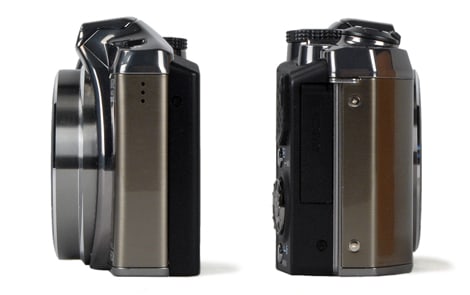
Olympus SZ-31MR iHS side views
Running Cost
{{section_header}}{{section.name}}{{/section_header}}
The {{product.name}} is by far one of the most efficient fridges we've seen, both in its class and generally speaking. Using a $0.09 per kW-h standard, we determined it would only cost $28.34 per year to operate. This is an exceptionally low amount, and a rate which is bound to save you money in the long run.
Power Use Per Cu Ft
{{section_header}}{{section.name}}{{/section_header}}
Obviously, not all fridges are created equally, and a lot of factors go into determining how much energy is used by a given appliance. For that reason, we take the amount of energy used and figure out how much of it is distributed per cubic foot of usable storage space in order to create a general standard. With that in mind, this {{product.brand.name}} uses just 0.05 kW-h per cubic foot of space. This is, in a word, fantastic. Most fridges can't even come close to this level of energy efficiency.
Fridge Temperature
{{section_header}}{{section.name}}{{/section_header}}
This {{product.brand.name}} exhibited near-perfect temperature consistency in its fridge. Over time, temperatures fluctuated less than a quarter of a degree, resulting in even temperatures ideal for food preservation. It was only near-perfect because the very bottom of the fridge was just a few degrees warmer than the rest of it, so you'll want to keep foods that need the lowest temperatures at the top.
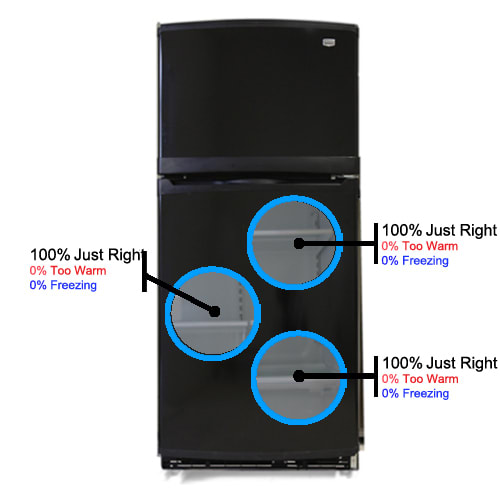
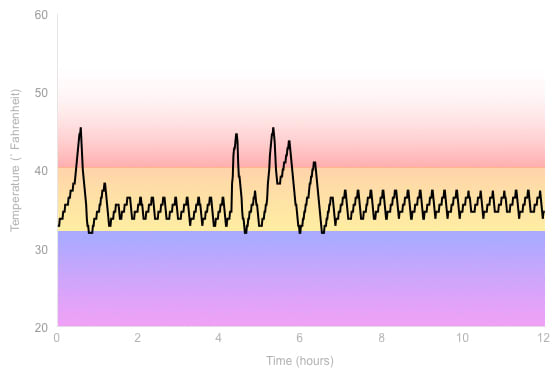
Freezer Temperature
{{section_header}}{{section.name}}{{/section_header}}
The freezer actually ran a little cooler than is normal, with temperatures a bit bellow zero degrees Fahrenheit. The consistency over time is something to be praised, an important point given that minimized temperature change like what we saw in the {{product.brand.name}} means your food will be safe from freezer burn.
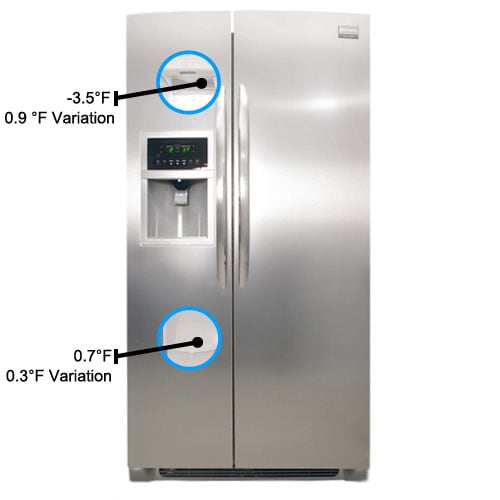
Vegetable Drawer
{{section_header}}{{section.name}}{{/section_header}}
The {{product.brand.name}}'s vegetable drawers performed adequately enough, but nothing quite so attention worthy as its other performance points. On average, our test material lost 0.18 grams of water per hour. Your vegetables will remain fresh and crisp for a few days, but they won't last an unusually long amount of time.
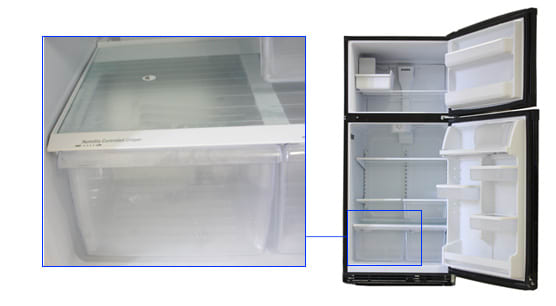
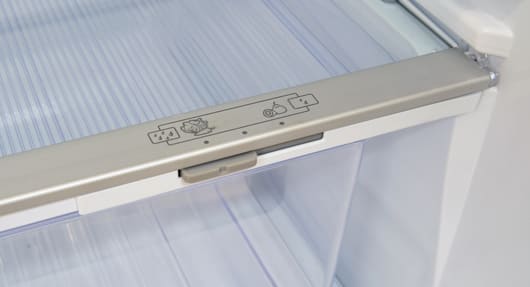
Power Loss
{{section_header}}{{section.name}}{{/section_header}}
After we pulled the plug to see how well the fridge kept food cold without power for 36 hours, items in the freezer were all still quite frozen. As long as you don't leave the door open, or have a questionable electric company, your food should be safe from short power outages.
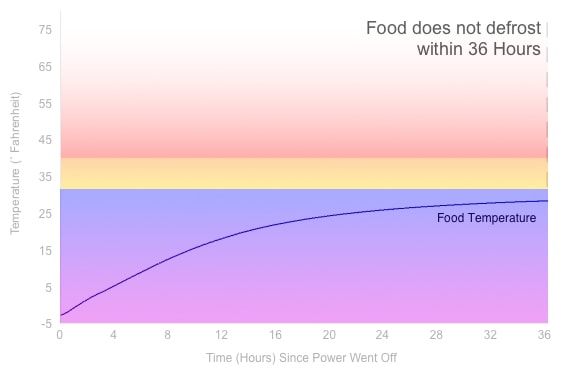
Freezing Performance
{{section_header}}{{section.name}}{{/section_header}}
It took one hour and 34 minutes to bring our room temperature test materials down to freezing. This isn't perfect - we've seen fridges do it in just about an hour flat - but it's better than some other models we've seen. Thawed food generally has a slightly inferior texture compared to their original quality, and efficient appliances are able to minimize the effect but cutting down on freezing time.

Usable Space
{{section_header}}{{section.name}}{{/section_header}}
The {{product.brand.name}} has a very traditional layout. Four half-width shelves, a full width shelf under those, a deli drawer, and two vegetable drawers at the very bottom. All of these add up to a total of 11.34 cubic feet of usable space. It's not exactly expansive, but there's more than enough space for a good number of consumers. This fridge should be large and spacious enough for all but the largest of families.
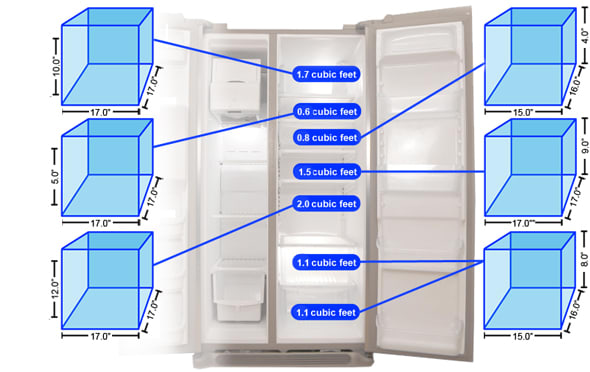
Some of the fridge storage is found on its door, which contains a variety of shelves. Three of those shelves are half-width, adjustable buckets that can be rearranged to suit your storage needs. In addition is a dairy bin on the top and a full-width shelf on the bottom. The unusual addition here is found next to the dairy bin - a flat, open tray not usually seen in fridges.
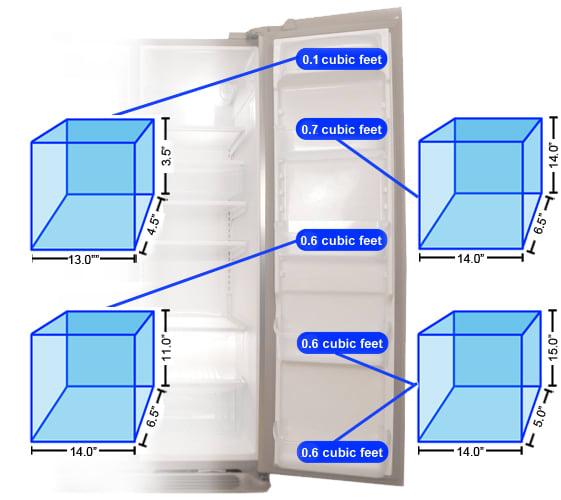
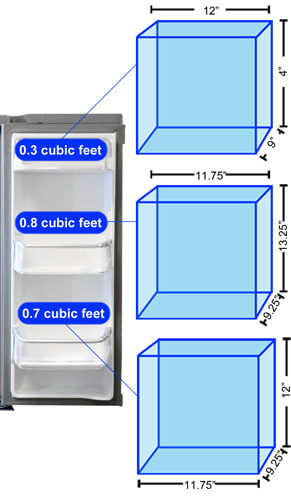
The freezer actually holds a fair amount, by top-freezer standards. After removing space taken up by the ice maker, the two shelves in here can store a total 4.71 cubic feet of assorted goods. This total doesn't account for space taken up by the ice tray, since that can be removed and doesn't have to be utilized.
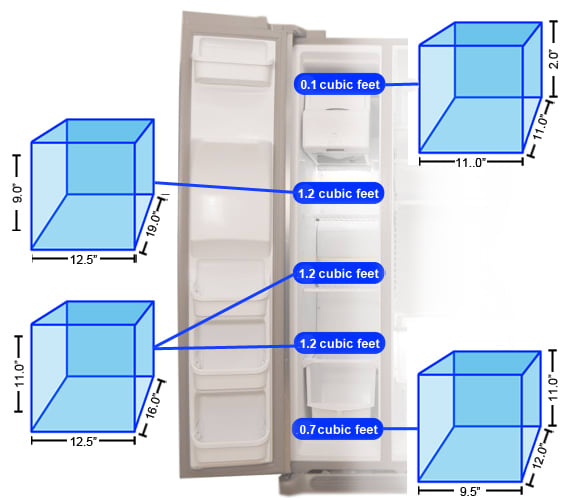
Door storage in the {{product.brand.name}}'s freezer is a bit strange. Some of it is found in a regular, run-of-the-mill shelf that runs the full width of the bottom. Above that is an unusual...cage, would be the best description. The shelf consists of a tilting wire cage that pulls forward, allowing you to slip your food in from the top. It's actually an ingenious idea, as it allows you to stack goods that might otherwise sit precariously in a normal shelf without the risk of them falling out when you open the door.
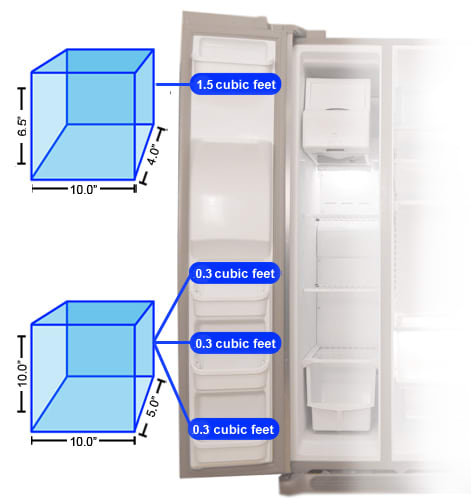
Below are the manufacturers own figures for capacity, and our own measurements for usable capacity. The manufacturers figures do not take account of the shelves, drawers and other removable features, but our measurements do account for the space these take up.
Ease of Access
{{section_header}}{{section.name}}{{/section_header}}
The fridge is more or less accessible, but has a few spots that can be hard to reach. Since it's a top-freezer, some of the parts furthest back might be troublesome since you'll have to stoop to reach them, and you'll want to store things under the deli drawer only as a last resort. The freezer, too, is quite open, but the drawback here is found in the funky shelf on the door. The tipping wire cage may make for interesting storage options, but if you start stacking different things and want something on the bottom, there's no way to get to it without taking everything else out first.
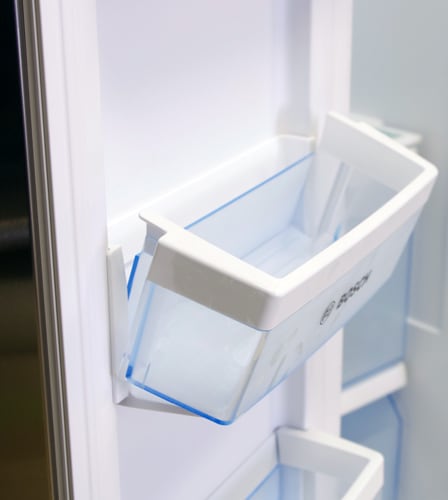
Controls
{{section_header}}{{section.name}}{{/section_header}}
There are two sets of controls on this fridge, but both are very low-tech and easy to learn. In the fridge, right in front at the top of the compartment, is a little scale from 1 to 5 that controls that fridge's temperature. There's a button to push in order to adjust it, as well as a button that locks the water dispenser shut and a warning light notifying you when the filter needs to be changed. In the freezer is a simple switch that can be pushed up or down to select a number from 1 to 5. Both of these have a clearly labeled manufacturer's recommended setting.
The controls aren't quite baseline in terms of complication, but they are very simple. The buttons on the fridge's console respond well to pressing, and the green-lit number indicator is straightforward and easy to read. The freezer just has a flippable handle which is even easier, though you'll want to make sure you don't hit it and adjust the temperature with some of your food items.

Water Dispenser
{{section_header}}{{section.name}}{{/section_header}}
The water dispenser is a bit unusual, and you may find yourself accidentally bumping it from time to time. Fortunately, that prominence makes it very easy to get to, and its simplicity makes it easy to use. If you find yourself bumping it too often, though, but want to leave it connected, take advantage of the simple water lock on the fridge's control panel.

Ice Maker
{{section_header}}{{section.name}}{{/section_header}}
The ice maker is of a traditional kind, located in the top left corner of the freezer and operated using a single switch.

Cleaning
Noise
Other Features
{{section_header}}{{section.name}}{{/section_header}}
{{product.manufacturer_specs['Other Features Photo BROKEN?']}}
Conclusion
Energy Efficiency
Even if you can't find the appliance on sale, this {{product.brand.name}} will save you a bundle in your electric bill. With a yearly operating cost of $28.34 per year and a power distribution of just 0.07 kWh per cubic foot of energy, this fridge does as good a job of keeping your electric bill down as it does keeping your food fresh.
Performance
The temperature consistency in this appliance is just short of perfect. With nearly no degree fluctuation in either the fridge or freezer, you won't have to worry about an increased rate of spoiled foods or a rapid development of freezer burn. Moisture retention is substantial, meaning your fresh produce will stay that way long enough that you shouldn't have any trouble eating it all, and the freezer manages to bring items down from room temperature in enough time to offer you thawed goods of reasonable quality.
Storage Space
This appliance isn't cavernous, and that's okay. The space is well balanced, offering plenty of room in either the fridge or freezer, and it's spacious enough that any consumer—except maybe Octo-mom—should have enough room to store anything they might want.
Usability
The {{product.brand.name}} uses a very traditional set up of half-width shelves and rear mounted hooks in the fridge. It's not the easiest design to customize, but you shouldn't have many hassles getting to food as long as you don't bury things in the back. The shelves are small enough to remove for cleaning without much a problem, too. Controls are straightforward and easy to use, as well, but the temperature settings have no correlation with any actual degree scale. You many want to buy a thermometer just to make sure that you're not making things too warm or two cold in there.
Meet the tester
Matthew is a native of Brockton, MA and a graduate of Northeastern, where he earned a degree in English and Theatre. He has also studied at the Gaiety School of Acting in Dublin and spends most of his free time pursuing a performance career in the greater Boston area.
Checking our work.
Our team is here to help you buy the best stuff and love what you own. Our writers, editors, and experts obsess over the products we cover to make sure you're confident and satisfied. Have a different opinion about something we recommend? Email us and we'll compare notes.
Shoot us an email